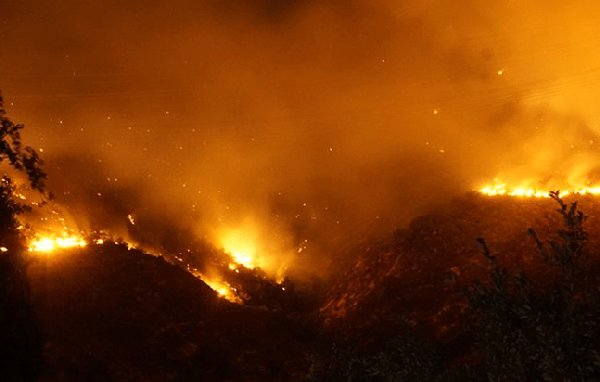- Chile:24 de Agosto de 2018
Plantaciones forestales son una de las razones de los masivos incendios ocurridos en Territorio Mapuche
Montana, USA, 27 de agosto de 2018. (stopgetrees.org)– Un equipo de investigadores de la Universidad Estatal de Montana (MSU), en Estados Unidos, señaló varias razones de los masivos incendios ocurridos en el centro-sur de Chile en 2017. “Además de la baja humedad, los fuertes vientos y las temperaturas extremas -algunos de los mismos factores que contribuyen a los incendios que azotan Estados Unidos-, el centro de Chile está experimentando una mega sequía y gran parte de sus diversos bosques nativos se han convertido en plantaciones de árboles más inflamables”, señalaron los académicos.

Sus resultados fueron publicados este 22 de agosto en PLOS ONE, una revista científica en línea publicada por Public Library of Science.
El autor principal, Dave McWethy, profesor asistente en el Departamento de Ciencias de la Tierra de MSU en la Facultad de Letras y Ciencias, dijo que Chile ha reemplazado muchos de sus bosques nativos con bosques de plantaciones para abastecer fábricas de pulpa y madera que producen papel y productos de madera. Como resultado, dijo, los bosques de pinos y eucaliptos no nativos altamente inflamables ahora cubren la región. Los árboles de eucalipto, que son nativos de Australia, y los árboles de pino nativos de los Estados Unidos, contienen aceites y resinas en sus hojas que, cuando están secas, pueden encenderse fácilmente.
“Chile reemplazó bosques nativos más heterogéneos y menos inflamables con plantaciones forestales exóticas estructuralmente homogéneas e inflamables en un momento en que el clima es cada vez más cálido y seco”, afirmó McWethy.
Advirtió además que “esta situación probablemente facilitará que los incendios futuros se propaguen más fácilmente y promoverá incendios más grandes en el futuro”.
El coautor de esta investigación, Anibal Pauchard, profesor de la Universidad de Concepción e investigador del Instituto de Ecología y Biodiversidad de Chile, dijo que los incendios forestales han sido parte del paisaje chileno durante siglos, pero se han hecho más grandes y más intensos en las últimas décadas, a pesar de costosos esfuerzos del gobierno para controlarlos.
“Desafortunadamente, los incendios en el centro de Chile se promueven por el aumento de las emisiones humanas, el clima más seco y caliente, y la disponibilidad de abundantes combustibles inflamables asociados con plantaciones de pino y matorrales degradados dominados por especies invasoras”, dijo Pauchard.
--------------------------
Research determines reasons for massive fires in south-central Chile
PHYS.ORG: A Montana State University-led team has discovered several reasons why massive fires continue to burn through south-central Chile.
Besides low humidity, high winds and extreme temperatures—some of the same factors contributing to fires raging across the United States—central Chile is experiencing a mega drought and large portions of its diverse native forests have been converted to more flammable tree plantations, the researchers said.
Their results were published Aug. 22, in PLOS ONE, an online scientific journal published by the Public Library of Science.
Lead author Dave McWethy, an assistant professor in MSU’s Department of Earth Sciences in the College of Letters and Science, said Chile has replaced many of its native forests with plantation forests to supply pulp and timber mills that produce paper and wood products. As a result, he said, highly flammable non-native pine and eucalypt forests now cover the region. Eucalypt trees, which are native to Australia, and pine trees native to the United States contain oils and resins in their leaves that, when dry, can easily ignite.
“Chile replaced more heterogenous, less flammable native forests with structurally homogenous, flammable exotic forest plantations at a time when the climate is becoming warmer and drier,” said McWethy. “This situation will likely facilitate future fires to spread more easily and promote more large fires into the future.”
Co-author Anibal Pauchard, professor at the University of Concepcion and researcher at the Institute of Ecology and Biodiversity in Chile, said wildfires have been a part of the Chilean landscape for centuries, but they have grown larger and more intense in recent decades, despite costly government efforts to control them.
“Unfortunately, fires in central Chile are promoted by increasing human ignitions, drier and hotter climate, and the availability of abundant flammable fuels associated with pine plantations and degraded shrublands dominated by invasive species,” Pauchard said.
Read the full report here:
https://phys.org/news/2018-08-massive-south-central-chile.html#jCp
The Campaign to STOP GE Trees and Global Justice Ecology Project has worked to expose the dangers of monoculture tree plantations in Chile.
See our Chile Blog here.
Fuente:
https://stopgetrees.org/research-determines-reasons-for-massive-fires-in-south-central-chile/1933





